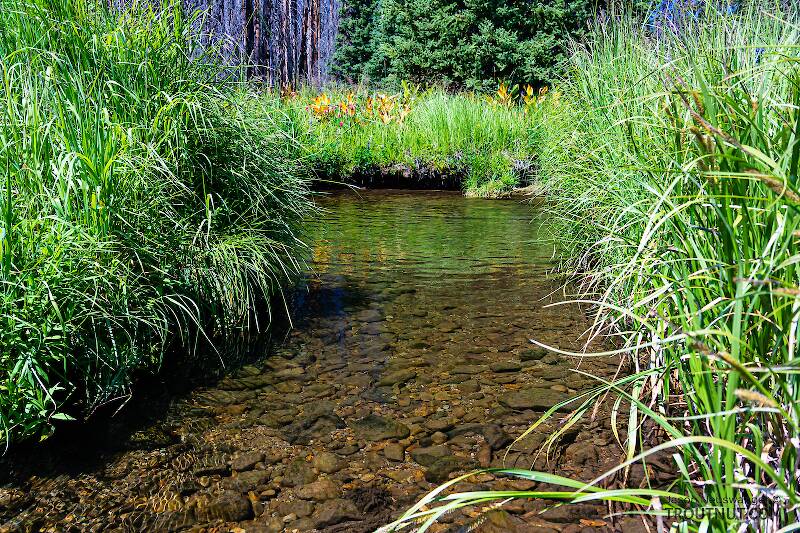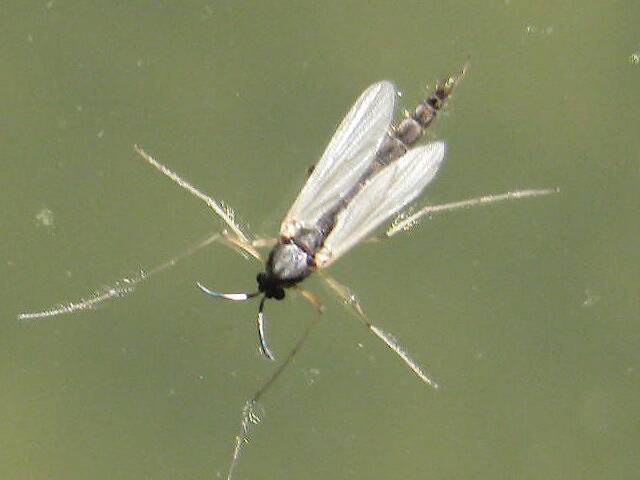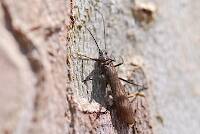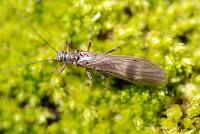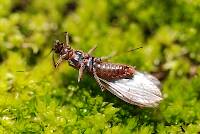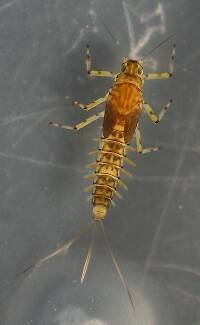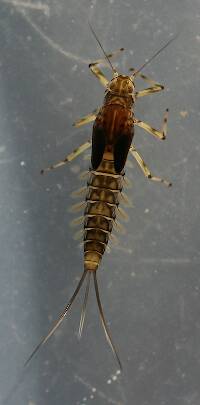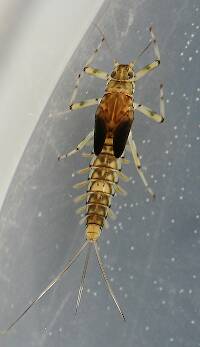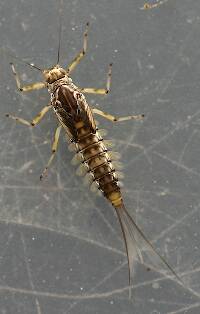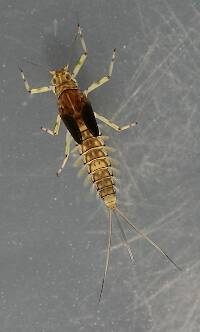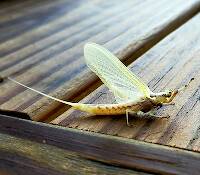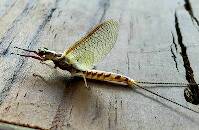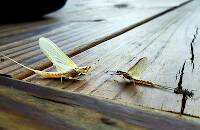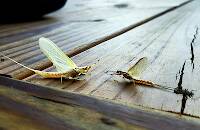
Salmonflies
Pteronarcys californica
The giant Salmonflies of the Western mountains are legendary for their proclivity to elicit consistent dry-fly action and ferocious strikes.
Featured on the forum

Troutnut is a project started in 2003 by salmonid ecologist Jason "Troutnut" Neuswanger to help anglers and
fly tyers unabashedly embrace the entomological side of the sport. Learn more about Troutnut or
support the project for an enhanced experience here.
Wiflyfisher on Feb 3, 2010February 3rd, 2010, 7:57 am EST
Okay, name that bug...

Full view here: http://www.wiflyfisher.com/images/april-stonefly.jpg
March / April hatch in the Upper Midwest.

Full view here: http://www.wiflyfisher.com/images/april-stonefly.jpg
March / April hatch in the Upper Midwest.
John S.
https://WiFlyFisher.com
https://WiFlyFisher.com
Oldredbarn on Feb 3, 2010February 3rd, 2010, 9:22 am EST
Taeniopteryx nivalis....Just a guess here...An Early Black Stone?
Spence
I've already hedged my bet due to in only being 2/3...But I'm not sure just how old the photo is...My second guess: Allocapnia granulata...These may be out and about now...Tiny Black Stone...I was just looking at a penny and trying to gauge the hook size...I may stick with my first guess...Just call me wishy-washy!
Spence
I've already hedged my bet due to in only being 2/3...But I'm not sure just how old the photo is...My second guess: Allocapnia granulata...These may be out and about now...Tiny Black Stone...I was just looking at a penny and trying to gauge the hook size...I may stick with my first guess...Just call me wishy-washy!
"Even when my best efforts fail it's a satisfying challenge, and that, after all, is the essence of fly fishing." -Chauncy Lively
"Envy not the man who lives beside the river, but the man the river flows through." Joseph T Heywood
"Envy not the man who lives beside the river, but the man the river flows through." Joseph T Heywood
Falsifly on Feb 3, 2010February 3rd, 2010, 10:07 am EST
What have I got to lose, I haven’t hit one yet. I would say from the Family Capniidae but the tails should be visible. That leaves me thinking Leuctridae. Those wings do appear rolled but I understand how deceptive photos can be.
Falsifly
When asked what I just caught that monster on I showed him. He put on his magnifiers and said, "I can't believe they can see that."
When asked what I just caught that monster on I showed him. He put on his magnifiers and said, "I can't believe they can see that."
Wiflyfisher on Feb 3, 2010February 3rd, 2010, 1:55 pm EST
The best I could tell is it is the same bug as what Jason collected. Both stoneflies are from the same river. But mine was from last Spring and Jason's photos were from 2004.
Strophopteryx fasciata (Early Brown Stonefly)
http://www.troutnut.com/specimen/346
Strophopteryx fasciata (Early Brown Stonefly)
http://www.troutnut.com/specimen/346
John S.
https://WiFlyFisher.com
https://WiFlyFisher.com
Troutnut on Feb 19, 2010February 19th, 2010, 9:26 am EST
Looks pretty close to me, although I think there are multiple species of Taeniopgerygids in that river and I can't tell the adults apart at a glance.
Jason Neuswanger, Ph.D.
Troutnut and salmonid ecologist
Troutnut and salmonid ecologist
Entoman on Mar 23, 2012March 23rd, 2012, 10:59 am EDT
I think John is right, the wing venation looks to match fasciata (Mottled Willowfly). The photo is in a bit of shadow so the light mottling of the wings is hard to make out.
"It's not that I find fishing so important, it's just that I find all other endeavors of Man equally unimportant... And not nearly as much fun!" Robert Traver, Anatomy of a Fisherman
Wiflyfisher on Mar 23, 2012March 23rd, 2012, 12:07 pm EDT
Kurt, mine came from the same river and the same time period as Jason's stonefly (although different year), so I assumed that it is the same.
http://www.troutnut.com/specimen/346

http://www.troutnut.com/specimen/346

John S.
https://WiFlyFisher.com
https://WiFlyFisher.com
Entoman on Mar 23, 2012March 23rd, 2012, 5:17 pm EDT
Yep, there's the mottled wings.
"It's not that I find fishing so important, it's just that I find all other endeavors of Man equally unimportant... And not nearly as much fun!" Robert Traver, Anatomy of a Fisherman
Entoman on Mar 23, 2012March 23rd, 2012, 10:09 pm EDT
Al - An easy way to often tell leuctrids (needleflies) at a glance is that their wings are usually pretty close to abdomen width at mid-wing when fully folded (enveloped is a better word). They're also much slenderer critters than the willowflies.
http://bugguide.net/node/view/442464
Spence - You were closer with your first guess, though Taeniopteryx nivalis (Boreal Willowfly aka February Red) is in a different subfamily. It is also a much larger insect and usually more brownish as the common name implies. The nymphs can be 3/4" body length.
As for you other guess, the easiest way to tell capniids (snowflies) from other little dark Winter stones (besides usually being the tiniest) are the long tails jutting out from under their wings. The others are vestigial.
http://eol.org/pages/613448/overview
http://bugguide.net/node/view/442464
Spence - You were closer with your first guess, though Taeniopteryx nivalis (Boreal Willowfly aka February Red) is in a different subfamily. It is also a much larger insect and usually more brownish as the common name implies. The nymphs can be 3/4" body length.
As for you other guess, the easiest way to tell capniids (snowflies) from other little dark Winter stones (besides usually being the tiniest) are the long tails jutting out from under their wings. The others are vestigial.
http://eol.org/pages/613448/overview
"It's not that I find fishing so important, it's just that I find all other endeavors of Man equally unimportant... And not nearly as much fun!" Robert Traver, Anatomy of a Fisherman
Quick Reply
Related Discussions
Topic
Replies
Last Reply
6
Aug 21, 2010
by Gutcutter
by Gutcutter
2
Jul 9, 2018
by Martinlf
by Martinlf

